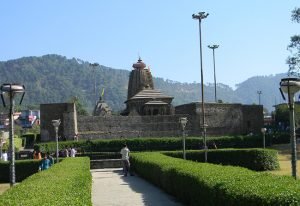This particularly beautiful ancient Shiv temple at Baijnath Temple is 16 km from Palampur, on the Pathankot-Mandi national highway. Built of stone in the 9th century AD in the shikhara style, it is a fine blend of sculpture and architecture. The temple is easily accessible from both Palampur and Kangra. The linga enshrined in its sanctum is one of the 12 Jyotirlingas in the country. Every year during the Shivratri fair, pilgrims descend on Baijnath for the colorful fair and festivities.
 The Baijnath Mandir has located 16 km from Palampur in the Beas valley and is dedicated to Lord Shiva. Shiva is worshipped here as Vaidyanath or the Lord of Physician. The temple has lent its name to town as well which earlier was known as Kiragrama. The history of the temple is stated on stone slabs. According to it, the temple foundation was laid down by two local merchants in the 9th century. The date of the inscription is itself given in two eras – Saptarshi and Saka.
The Baijnath Mandir has located 16 km from Palampur in the Beas valley and is dedicated to Lord Shiva. Shiva is worshipped here as Vaidyanath or the Lord of Physician. The temple has lent its name to town as well which earlier was known as Kiragrama. The history of the temple is stated on stone slabs. According to it, the temple foundation was laid down by two local merchants in the 9th century. The date of the inscription is itself given in two eras – Saptarshi and Saka.
The Saka year 1126, which corresponds to 1204 AD, is considered more authentic. Renovation work in the temple was carried out by Raja Sansar Chand in the 19th century. Today, the temple is still very much in use and attracts a number of visitors year-round. The unique feature of the temple is its architectural style, which is very different from the rest of the temple in the state. Actually, the architectural style is Orissan which is far away from Himachal.
History of Baijnath Temple:
The history of the Baijnath Temple itself is given in the two long inscriptions fixed in the walls of the mandapa of the temple. Accordingly we are told that Kiragrama (modern Baijnath) situated on the bank of the river Binduka was a part of Trigarta (the territory lying between the rivers Ravi and Satluj, roughly represented by districts of Kangra and Jalandhar) under the suzerainty of king Jayachandra, the overlord of Jalandhara. Under him a Rajanaka (local chief) Lakshmanachandra, who was matrimonially related to Jayachandra from his mother’s side, was ruling over Kiragrama. Genealogy of Lakshmanachandra (see box) is given in these inscriptions.
At Kiragrama resided two brothers, Manuka and Ahuka, sons of a merchant named Siddha. Their genealogy up to the fourth generation is also mentioned in the inscriptions (see box). They out of their devotion to Siva Vaidyanatha constructed the temple under discussion in Saka 1126 (CE 1204). They also donated a machine for extracting oil, a shop, and some land in the village called Navagrama (modern Nauri near Baijnath) to the Baijnath Temple. The Rajanaka Lakshmanachandra and his mother also made some donations to the temple in the form of money and land respectively.
The inscriptions tell us that a Sivalinga is known as Vaidyanatha already existed on the spot but was without a proper house so the present temple and a porch in its front were constructed. It clearly indicates that a shrine already existed on the spot before the construction of the present temple.
What happened to the shrine in the centuries that followed is not exactly known but it appears to have continued under worship, as there is clear evidence of repairs and renovations from time to time. In the 18th century Sansara Chandra II, the Katoch king of Kangra, carried out extensive repairs and renovations of the temple. Alexander Cunningham noticed an inscription of 1786 in the temple referring to its renovations by Sansara Chandra. An inscription on the wooden doors of the sanctum of the temple provides the date as samvat 1840 (AD 1783) that is very near to Cunningham’s date.
The devastating earthquake that shook the entire region of Kangra on 4th April 1905 also caused damage to the shrine, which has been reported by J. Ph. Vogel and has since been repaired. At present the temple is a protected monument under the Archaeological Survey of India but the performance of worship and rituals are under a local board at Baijnath with SDM as its chairman. The hereditary priests continue to get a share of the offerings.
Legends As per a legend, it is believed that the King of Lanka, Ravana had worshipped Lord Shiva in the main Baijnath Temple. He sacrificed his head ten times at a place marked out in the temple. And because of this, the people here do not consider it right to celebrate Dussehra which remembers the day when Lord Rama killed Ravana. The people here think that celebrating Dussehra can offend Lord Shiva a lot. In the past too, whenever any attempt has been made to celebrate the festival, the organizer died within years. Though the fact is that the deaths were in no way related to the celebration of Dussehra, the people here linked the two. Currently plans are again on to start the celebration of Dussehra in a nearby stadium.



